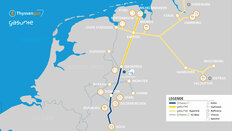- A 400-km hydrogen pipeline will connect Wilhelmshaven to Cologne by 2028.
- The project involves converting existing pipelines and constructing new sections.
- Gasunie and Thyssengas have submitted PCI applications to the European Commission.
- The pipeline will link hydrogen clusters Hyperlink and GETH2.

Project Overview
Gasunie and Thyssengas are planning a 400-kilometer hydrogen pipeline connecting Wilhelmshaven to Wesseling near Cologne by 2028. This north-south corridor will transport hydrogen produced in Wilhelmshaven or imported from Norway to key industrial regions on the Rhine and Ruhr.
Implementation and Infrastructure
The project will involve converting existing transport pipelines and constructing new sections. Both companies have submitted PCI applications to the European Commission for the two sections of the pipeline, highlighting the project's significance.
Hydrogen Clusters and Connectivity
The pipeline will link existing hydrogen clusters, including Gasunie's Hyperlink network in the north and Thyssengas's GETH2 initiative in the south. This connection will facilitate hydrogen supply from Münsterland through the Ruhr region to the Rhineland, supporting the development of an integrated hydrogen network in Germany.
Section Details
The northern section will connect hydrogen production and import facilities on the North Sea coast, including the Wilhelmshaven Energy Hub and a planned hydrogen export pipeline from Norway. The southern section will integrate with other H2 pipeline projects, connecting consumption centers in North Rhine-Westphalia to the north-south corridor.
Strategic Importance
This project aims to meet the hydrogen needs of SMEs and industry by 2028, ensuring a reliable and cost-effective transport route. The integrated network planning will support medium-sized companies and large consumers, such as chemical parks and steel producers, with a realistic prospect of hydrogen supply in the near future.

